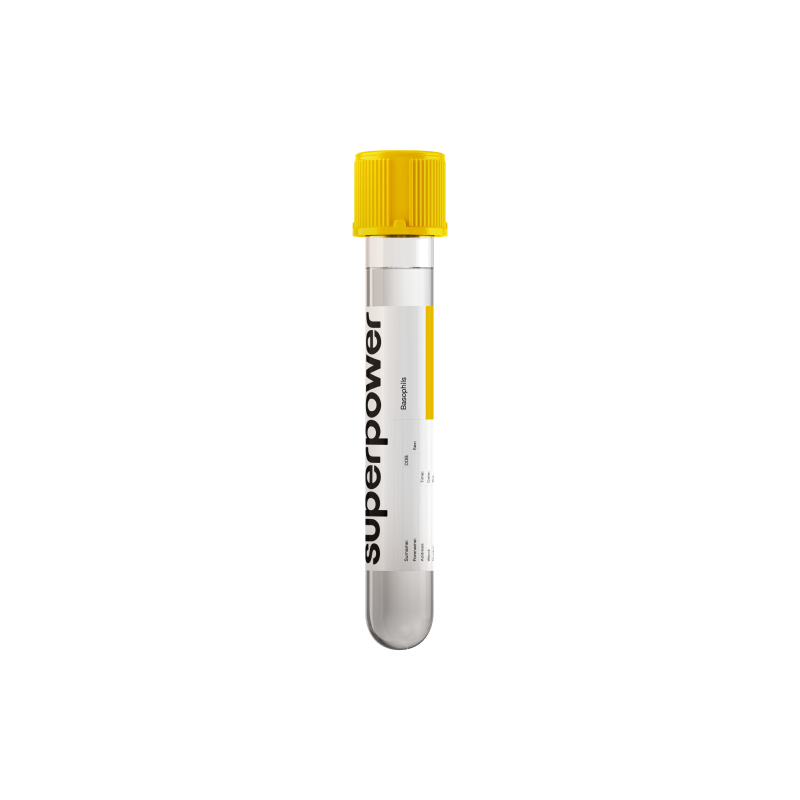Basophil counts provide context for asthma, eczema, hives, or sinus issues. They shift with stress, thyroid balance, infection recovery, and medications.
Testing helps distinguish routine fluctuations from meaningful allergic or immune signals, and when paired with eosinophils and IgE, it sharpens the map of type-2 inflammation.
Key Benefits
- See how an allergy-related white blood cell is behaving in your blood.
- Spot histamine-driven activity that may explain hives, flushing, or nasal allergies.
- Flag marked basophilia that can signal myeloproliferative diseases like CML.
- Clarify high white counts by distinguishing allergic inflammation from marrow disorders.
- Guide care by tracking basophils during treatment for CML and related conditions.
- Explain low counts as effects of stress, steroids, or hyperthyroidism.
- Support parasite or allergy evaluation when reviewed with eosinophils and total WBC.
- Best interpreted with your symptoms, eosinophils, and full CBC differential results.
What is Basophils?
Basophils are a rare type of white blood cell with deep purple granules filled with inflammatory messengers. They are produced in the bone marrow from myeloid precursors and circulate in the bloodstream, moving into tissues when called by inflammation. Their granules store histamine and related signals, and their surface carries the high‑affinity receptor for allergy antibodies (IgE; FcεRI). Under the microscope they are granulocytes, kin to neutrophils and eosinophils, but marked by coarse granules and a lobed nucleus.
Basophils function as rapid alarm cells for allergic-type defense and parasite immunity (type 2 immunity). When allergens cross‑link IgE on their surface, they release histamine, leukotrienes, and cytokines such as IL‑4 and IL‑13. These signals make blood vessels leaky, tighten smooth muscle, and recruit other immune cells, especially eosinophils and Th2 lymphocytes. In doing so, basophils help initiate and amplify inflammation, support antibody class switching, and coordinate with tissue mast cells. Their presence in blood reflects the body’s readiness for immediate hypersensitivity responses and for orchestrating eosinophil‑rich inflammation.
Why is Basophils important?
Basophils are the rarest circulating white blood cells, but they punch above their weight in allergic defense and parasite control. Triggered by IgE, they release histamine, leukotrienes, and heparin—chemicals that open blood vessels, tighten airways, and signal in skin and gut. That makes them key influencers of vascular tone, breathing, and barrier tissues across the body.
On a standard report they typically make up about 0–1% of white cells, and many healthy people read as “0.” Optimal physiology sits at the very low end: present but quiet.
When the count is very low or undetectable, it usually reflects redistribution or suppression by stress hormones, acute infection, or corticosteroid exposure. This state does not itself cause symptoms; any issues come from the underlying trigger (such as fever or stress). Values are broadly similar in men and women and across ages, with interpretation driven more by context than by sex.
Higher values suggest a primed allergic or antiparasite response. In asthma and atopic conditions, basophils amplify itching, hives, runny nose, flushing, and wheeze via histamine and leukotrienes, often alongside eosinophils and elevated IgE. Helminth infections can recruit them to skin and gut, causing rashes or cramping. Marked, persistent elevations—especially with anemia, very high platelets, or an enlarged spleen—raise concern for a myeloproliferative process.
Big picture: basophils sit at the crossroads of immunity, coagulation, and vascular permeability, partnering with mast cells and eosinophils. Their count is a small but telling readout of allergic–parasitic activity or bone marrow signaling, with implications for respiratory health, skin reactivity, and long-term inflammatory burden.
What Insights Will I Get?
What Basophils tells you
Basophils measure how many of these rare granulocytes are circulating among your white blood cells. They carry histamine, leukotrienes, and cytokines, and partner with IgE to drive immediate allergic responses and defense against certain parasites. Because they modulate blood vessel permeability and smooth muscle tone, they link immune surveillance to vascular stability, airway reactivity, and skin/mucosal inflammation.
Low values usually reflect transient suppression or redistribution under stress hormones and acute inflammation. This is common with infections, after surgery, or with glucocorticoid exposure, and in hyperthyroidism. Pregnancy often shows lower basophils due to dilution and hormonal effects. Basopenia rarely causes symptoms itself; it signals a stress-response state rather than an immune deficiency.
Being in range suggests balanced Th2/allergic tone without ongoing activation. In healthy adults, basophils are naturally scarce, so values near the low end of the reference interval are typical. Stable in-range counts imply steady marrow output and quiescent mast cell–basophil signaling.
High values usually reflect allergic sensitization or active type 2 inflammation—such as eczema, allergic rhinitis, or asthma—or helminthic/parasite exposure. Counts can rise in hypothyroidism, during recovery from infections, after splenectomy, and in myeloproliferative neoplasms (notably chronic myeloid leukemia), especially when persistent and accompanied by other abnormal blood indices.
Notes: Interpretation depends on whether the report is a percentage or an absolute count; percentages can appear high or low simply because total white cells changed. Age and sex effects are small; atopy in children can track with higher values. Automated differentials vary slightly by analyzer, and timing, acute illness, and medications—especially corticosteroids—shift counts.



.svg)



.png)
.png)
.png)
.png)








